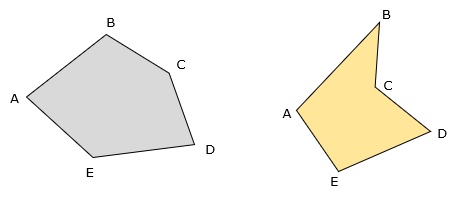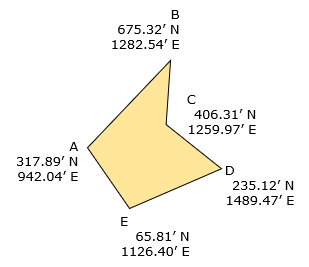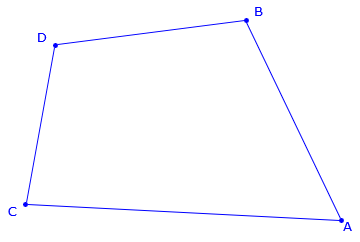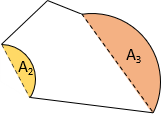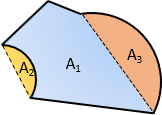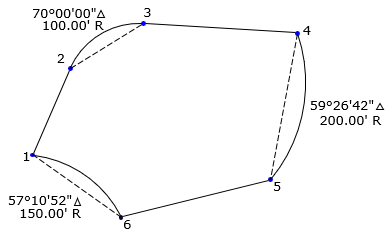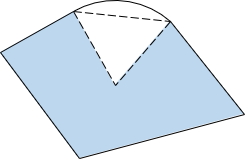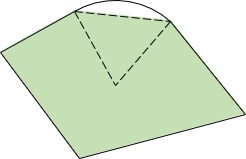H. Area
1. Traverse with straight sides
a. Closed polygon
The area of any closed non-crossing polygon, Figure H-1,
|
|
|
Figure H-1 |
can be computed using the coordinates of its verticies with Equation H-1:
|
|
Equation H-1 |
This equation works for any polygon with straight sides. The more verticies, the more terms in the equation. An easy way to remember equations is graphically:
|
Starting at one point, list the coordinates in sequence around the exterior. Repeat the first point at the end. |
|
|
Cross-multiply the coordinates. |
|
|
Sum the cross-products.
|
|
| Subtract one sum from the other, divide the result by two, and take the absolute value. This is the polygon area. |
|
It doesn't matter:
- at which point you start
- going clockwise or counterclockwise around the polygon
- whether coordinates are East-North or North-East
The last two can affect the area's mathematical sign which is why Equation H-2 uses the absolute value.
b. Example area computation
Determine the area of the traverse in Figure H-2.
|
|
|
Figure H-2 |
Set up the coordinates table with additional rows for first point repetition and sums and two columns for cross-products.
We'll start at point C, travel clockwise, and carry an extra significant figure to minimize cumulative rounding.
| Point | North (ft) | East (ft) | ||
| C | 406.31 | 1259.97 | ||
| D | 235.12 | 1489.47 | ||
| E | 65.81 | 1126.40 | ||
| A | 317.89 | 942.04 | ||
| B | 675.32 | 1282.54 | ||
| C | 406.31 | 1259.97 | ||
| sums: |
Partial cross-products:
![]()
406.31 x 1489.47 = 605,187
235.12 x 1126.40 = 264,489
...
![]()
235.12 x 1259.97 = 296,244
65.81 x 1489.47 = 98,022
...
The units on the cross-products are square feet.
Completed table:
| Point | North (ft) | East (ft) | ||
| C | 406.31 | 1259.97 | 296,244 | |
| D | 235.12 | 1489.47 | 605,187 | 98,022 |
| E | 65.81 | 1126.40 | 264,839 | 358,071 |
| A | 317.89 | 942.04 | 61,996 | 636,178 |
| B | 675.32 | 1282.54 | 407,707 | 521,109 |
| C | 406.31 | 1259.97 | 850,883 | |
| sums: | 2,190,612 | 1,909,624 |
![]()
Since we carried an extra significant figure, Area = 140,490 sq ft.
c. Non-crossing traverses only
Equation H-1 will not return a correct area if a traverse crosses itself. The traverse in Figure H-3 represents the order in which the points were surveyed, traverse adjusted, etc. Applying Equation H-1 to the coordinates in their surveyed order results in an "area" of 8,412 sq ft. The area is nonsensical since the traverse doesn't have an "inside" like a non-crossing polygon.
|
|
Coordinates
Area ABCDA = 8,412 sq ft. |
|||||||||||||||
|
Figure H-3 |
If we re-order the point list to a non-crossing perimeter, Figure H-4, the area is 70,717 sq ft.
|
|
Coordinates
Area ACDBA = 70,717 sq ft. |
|||||||||||||||
|
Figure H-4 |
Apply Equation H-1 only to a non-crossing traverse with the coordinates listed in order around the perimeter of the desired area.
2. Traverse with curves
a. Segments and sectors
Area by coordinates is constrained to following straight lines. Where curves are involved, Figure H-3(a), the method returns an area bounded by their chords, Figure H-3(b).
|
|
|
|
Figure H-3 |
|
To obtain the correct area, sector or segment areas are computed and added or subtracted accordingly. For the traverse in Figure H-3(a), the two segment areas are computed, Figure H-4(a), and one subtracted from, the other added to, the area by coordinates, Figure H-4(b).
|
(a) Segments |
(b) ATotal=A1-A2+A3 |
|
Figure H-4 |
|
b. Example area computation
Given the traverse in Figure H-5, determine its area.
|
|
|
Figure H-5 |
In the table below, the points and their coordinates are in the first three columns; their cross-products are in the last two.
| Point | North (ft) | East (ft) | ||
| 1 | 500.00 | 1200.00 | 737,634 | |
| 2 | 614.70 | 1249.70 | 624,850. | 843,243 |
| 3 | 674.76 | 1347.43 | 828,261 | 892,620. |
| 4 | 662.46 | 1552.76 | 1,047,730 | 725,778 |
| 5 | 467.41 | 1516.87 | 1,004,860 | 633,075 |
| 6 | 417.36 | 1317.39 | 615,766 | 658,696 |
| 1 | 500.00 | 1200.00 | 500,828 | |
| sums: | 4,491,046 | 4,622,300. |
The area is
![]()
This is the area bounded by the chords. We must account for the segments.
Recall that the area of a segment, bounded by an arc and its chord, is
|
|
Equation H-2 |
Compute the area of each segment
Arc 2-3

Arc 4-5

Arc 6-1

Add or subtract the segments:
![]()
Total traverse area is 68,790 sq ft.
c. Segment or sector?
Consider the curvinlinear traverse in Figure H-5:
|
|
|
Figure H-5 |
Its area can be computed using the arc sector, Figure H-6,
|
|
|
|
(a) Area to radial lines, AR |
(b) Sector area, ASec |
|
Figure H-6 Area = AR + ASec |
|
or using the arc segment, Figure H-7
|
|
|
|
(a) Area to chord, AC |
(b) Segment area, ASeg |
|
Figure H-7 |
|
Either method is fine. The only difference is that sectors require computing arc radius points, Figure H-6(a); segments do not, Figure H-7(a).
